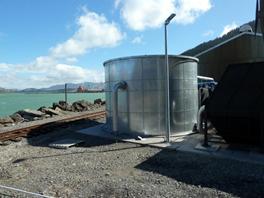A year-long earthquake swarm, which included three major earthquakes of 7.1, 6.3 and 5.9 magnitude, has had a major impact on the Christchurch region of New Zealand’s picturesque South Island. But despite being forced from its earthquake-affected offices, Tasman Tank Co was able to quickly move to new offices outside the red zone and continue operating throughout the devastation all around. In fact, Jason McLauchlan, Tasman Tanks’ General Manager, who hails from the area, says the company has increased its support of the region after the earthquakes hit, by expanding its Christchurch staff numbers.
“We have more than doubled our numbers in our Christchurch office, including additional drafts people and sales people. While our factory and offices have been declared uninhabitable, and look like they will have to be demolished, we have rented other premises and it’s business as usual for us,” said Mr McLauchlan, whose company produces more than 200 large industrial and municipal tanks a year. Demand for the company’s speedily erected bolted steel tanks has stepped up since they offered outstanding performance during the earthquakes, which included the February 2011 6.3 magnitude shake that caused widespread damage across Christchurch with damage exacerbated by buildings and infrastructure already weakened by the September 2010 7.1 magnitude earthquake and its aftershocks.
Significant liquefaction affected the eastern suburbs, producing around 400,000 tonnes of silt. The earthquake was reported to have been felt across the South Island and the lower and central North Island. In total, 181 people were killed in the earthquake, making it the second-deadliest natural disaster recorded in New Zealand (after the 1931 Hawke's Bay earthquake). Ian McGregor, Tasman Tank Co’s New Zealand Manager, says New Zealand’s second-most populous city is still getting aftershocks, “but the city is functioning. We understand from seismologist that the aftershocks are going to get less and less, however, before we had the last big one it was very quiet too.
“Just a couple of months ago we had a 4.5 magnitude earthquake, then prior to Christmas several significant quakes of 5.9 and 6 magnitude. Obviously there is a lot of construction work still to be done, including numerous concrete tanks that are cracked and leaking. Some of the tanks need to be demolished, but for some we can put a liner inside to keep the tank operational. One thing the earthquakes did prove was that the myth that concrete tanks are unbreakable and good for 100 years is not correct.”
Up until quite recently, concrete was the primary option for building high volume potable water storage facilities. “That however has changed over the last five years as enlightened councils and companies recognise the numerous benefits and savings of utilising the latest innovative bolted steel storage tanks.” Bolted tank designs are winning new friends across a wide variety of industries because of their content security, cost-efficiency and often because of the speed with which they can be erected on-site from modular components.
“In addition to providing a durable cost-efficient solution for the storage of both liquids and dry bulk goods, rolled tapered plate bolted tanks minimise exposure to delays caused by weather and reduce OH and S issues on-site. One of the biggest advantages of bolted tanks and dry bulk storage silos is the fact they can be safely constructed in the field in less than half the time required for field-weld construction,” says Mr McGregor.
Each Tasman Tank is certified to all relevant codes, with independent engineers providing verification of specifications and performance. The company provides cost-effective storage solution in capacities from kilolitres (KL) to 30 megalitres (ML).
Jason@tasmantanks.com.au



